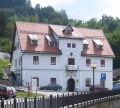Difference between revisions of "Category:Mercury mining heritage"
(improved) |
(...but some of its shafts and facilities remain open for tourists.) |
||
| Line 1: | Line 1: | ||
| − | For centuries [[Municipality of Idrija|Idrija]] with the world's second largest mercury mine was considered to be the centre of scientific and technological progress in the region. History of mining in Idrija dates back to year 1490. By burning cinnabar ore, the mercury miners of Idrija mined over 13 per cent of the world's production. Only Almadén mercury mine in Spain is bigger and dates back to Roman times. Until the World War I the Idrija Mercury Mine was one of the best technically equipped mine in Europe. In 1995 the mine was closed down due to commercial, geological and ecological reasons. | + | For centuries [[Municipality of Idrija|Idrija]] with the world's second largest mercury mine was considered to be the centre of scientific and technological progress in the region. History of mining in Idrija dates back to year 1490. By burning cinnabar ore, the mercury miners of Idrija mined over 13 per cent of the world's production. Only Almadén mercury mine in Spain is bigger and dates back to Roman times. Until the World War I the Idrija Mercury Mine was one of the best technically equipped mine in Europe. In 1995 the mine was closed down due to commercial, geological and ecological reasons but some of its shafts and facilities remain open for tourists. Since then the company has been under the liquidation, because it still needs to manage the consequences of 500 year mining, that is to secure the shafts and to monitor the pollution of the environment. |
The [[Idrija Mine Museum]] together with the [[Idrija Municipal Museum]] takes care of the region's rich technical, geological, technological, ethnological, and cultural heritage. In 2012 the ''Heritage of Mercury. Almadén and Idrija'' project was submitted to UNESCO in order to enter Idrija on its [[UNESCO World Heritage Sites in Slovenia|World Heritage List]]. | The [[Idrija Mine Museum]] together with the [[Idrija Municipal Museum]] takes care of the region's rich technical, geological, technological, ethnological, and cultural heritage. In 2012 the ''Heritage of Mercury. Almadén and Idrija'' project was submitted to UNESCO in order to enter Idrija on its [[UNESCO World Heritage Sites in Slovenia|World Heritage List]]. | ||
[[Category:Industrial and technical heritage]] | [[Category:Industrial and technical heritage]] | ||
Revision as of 15:01, 15 June 2012
For centuries Idrija with the world's second largest mercury mine was considered to be the centre of scientific and technological progress in the region. History of mining in Idrija dates back to year 1490. By burning cinnabar ore, the mercury miners of Idrija mined over 13 per cent of the world's production. Only Almadén mercury mine in Spain is bigger and dates back to Roman times. Until the World War I the Idrija Mercury Mine was one of the best technically equipped mine in Europe. In 1995 the mine was closed down due to commercial, geological and ecological reasons but some of its shafts and facilities remain open for tourists. Since then the company has been under the liquidation, because it still needs to manage the consequences of 500 year mining, that is to secure the shafts and to monitor the pollution of the environment.
The Idrija Mine Museum together with the Idrija Municipal Museum takes care of the region's rich technical, geological, technological, ethnological, and cultural heritage. In 2012 the Heritage of Mercury. Almadén and Idrija project was submitted to UNESCO in order to enter Idrija on its World Heritage List.
Articles in category "Mercury mining heritage"
The following 11 pages are in this category, out of 11 total.
Media in category "Mercury mining heritage"
The following 12 files are in this category, out of 12 total.
- Film Theatre Idrija 2014 Miners Theatre.JPG 1,920 × 1,080; 759 KB
- Idrija Mine Museum 2006 entrance.jpg 1,299 × 1,173; 218 KB
- Idrija Mine Museum 2011 Photo Stephen Colebourne.jpg 4,000 × 2,248; 1.91 MB
- Miner's House Idrija 2007 bread stove tools.JPG 1,536 × 2,048; 334 KB
- Miner's House Idrija 2007 closet.JPG 1,536 × 2,048; 341 KB
- Miner's House Idrija 2007 fireplace.JPG 2,048 × 1,536; 395 KB
- Miner's House Idrija 2007.JPG 1,536 × 2,048; 442 KB
- Miner's House Idrija 2007 lace making table.JPG 1,536 × 2,048; 337 KB
- Miner's House Idrija 2007 sink.JPG 1,536 × 2,048; 418 KB
- Municipality of Idrija 1689 Valvasor.jpg 955 × 768; 187 KB
- Municipality of Idrija 1840.jpg 793 × 576; 816 KB
- Municipality of Idrija 2008.jpg 1,600 × 1,200; 1.31 MB














